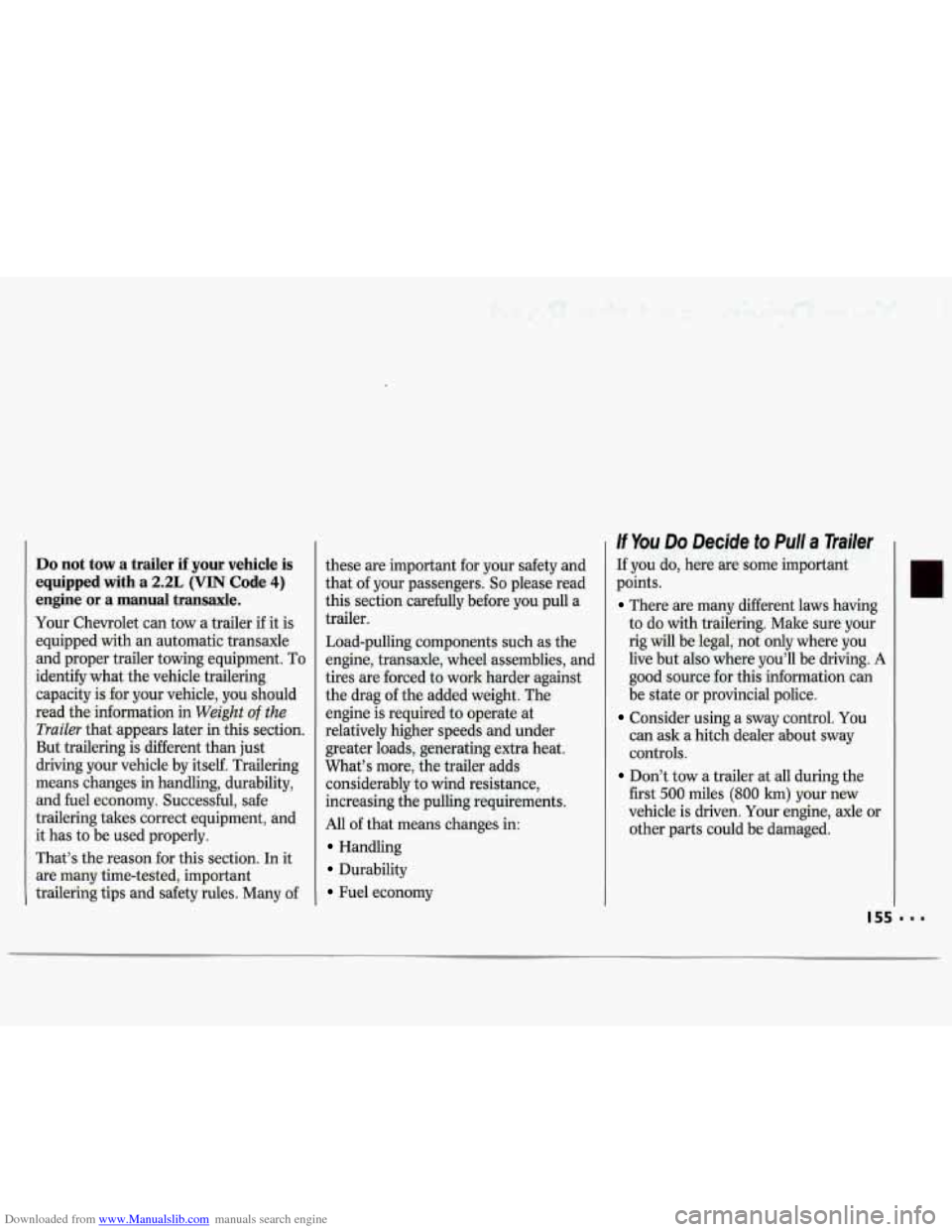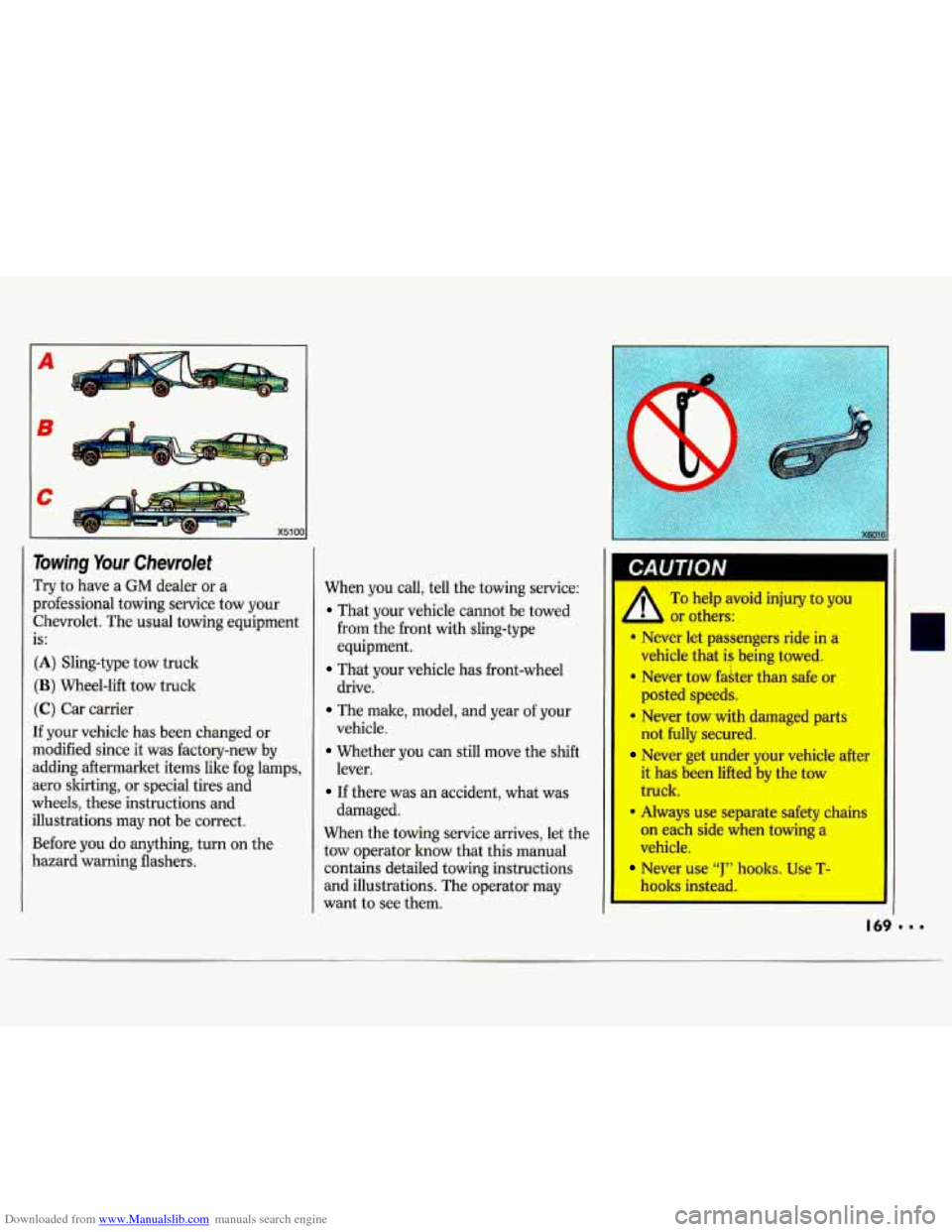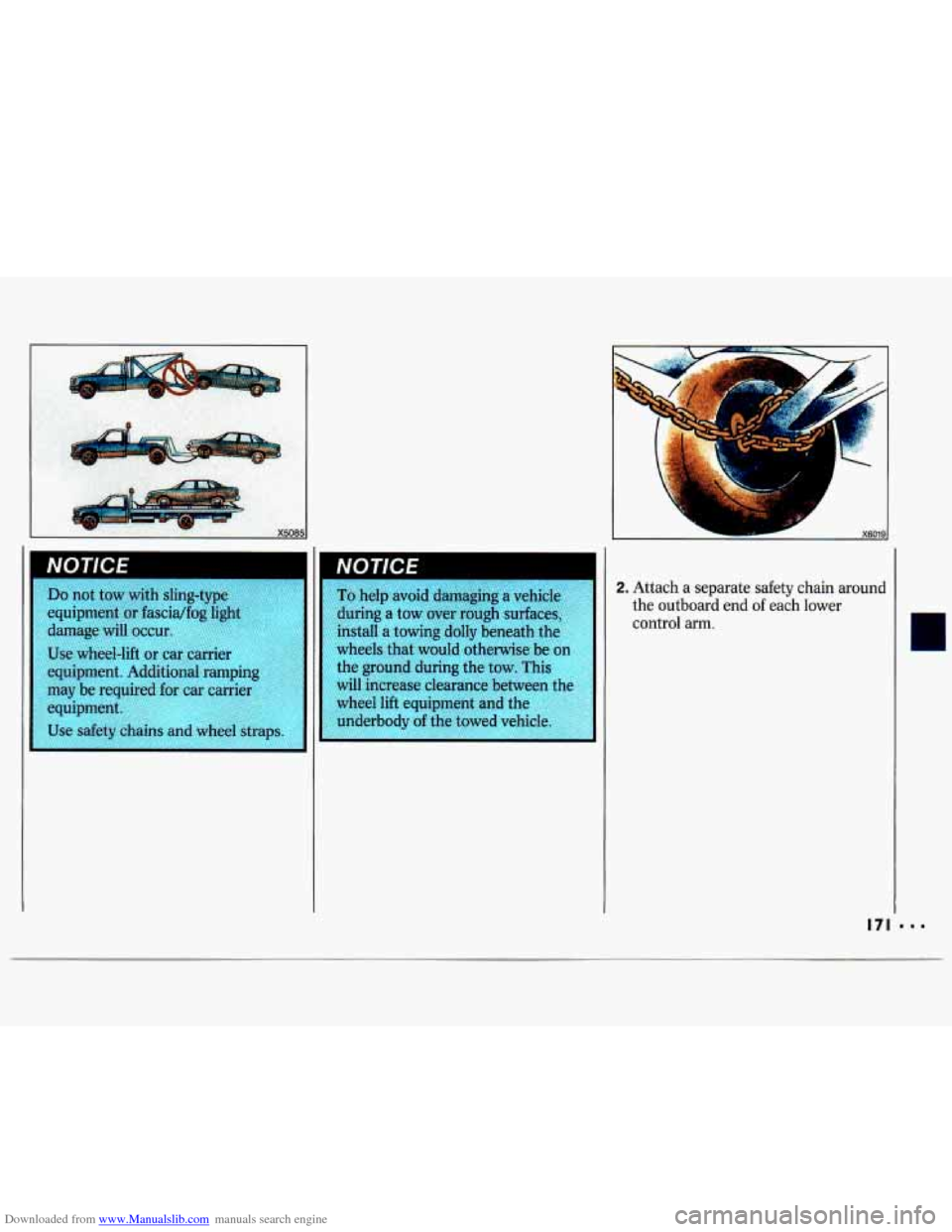1993 CHEVROLET LUMINA towing
[x] Cancel search: towingPage 157 of 324

Downloaded from www.Manualslib.com manuals search engine Do not tow a trailer if your vehicle is
equipped with a 2.2L (VIN Code 4)
engine or a manual transaxle.
Your Chevrolet can tow a trailer if it is
equipped with an automatic transaxle
and proper trailer towing equipment. To
identify what the vehicle trailering
capacity is for your vehicle, you should
read the information in
Weight of the
Trailer
that appears later in this section.
But trailering is different than just
driving your vehicle by itself. Trailering
means changes
in handling, durability,
and fuel economy. Successful, safe
trailering takes correct equipment, and
it has to be used properly.
That’s the reason for this section. In it
are many time-tested, important
trailering tips and safety rules. Many of these are important
for your safety and
that of your passengers.
So please read
this section carefully before you pull a
trailer.
Load-pulling components such as the
engine, transaxle, wheel assemblies, and
tires are forced to work harder against
the drag of the added weight. The
engine is required to operate at
relatively higher speeds and under
greater loads, generating extra heat.
What’s more, the trailer adds
considerably to wind resistance,
increasing the pulling requirements.
All of that means changes in:
Handling
Durability
Fuel economy
If You Do Decide to Pull a Trailer
If you do, here are some important
points.
There are many different laws having
to do with trailering. Make sure your
rig will be legal, not only where you
live but also where you’ll be driving.
A
good source for this information can
be state or provincial police.
Consider using a sway control. You
can ask a hitch dealer about sway
controls.
Don’t tow a trailer at all during the
first
500 miles (800 lun) your new
vehicle is driven. Your engine, axle or
other parts could be damaged.
Page 161 of 324

Downloaded from www.Manualslib.com manuals search engine Driving with a Trailer
Towing a trailer requires a certain
amount of experience. Before setting out for the open road, you’ll want to get
to know your rig. Acquaint yourself
with the feel of handling and braking
with the added weight of the trailer.
And always keep in mind that the
vehicle you are driving is now
a good
deal longer and not nearly
so responsive
as your vehicle is by itself.
Before you start, check the trailer hitch
and platform, safety chains, electrical connector, lights, tires and mirror
adjustment. If the trailer has electric
brakes, start your vehicle and trailer
moving and then apply the trailer brake
controller by hand to be sure the brakes
are worling. This lets you check your
electrical connection at the same time. During your
trip, check occasionally to
be sure that the load is secure, and that
the lights and any trailer brakes are still
working.
Following Distance
Stay at least twice as far behind the
vehicle ahead
as you would when
driving your vehicle without a trailer.
This can help you avoid situations that
require heavy braking and sudden
turns.
Passing
You’ll need more passing distance up
ahead when you’re towing a trailer.
And, because you’re a good deal longer,
you’ll need to go much farther beyond
the passed vehicle before you can return
to your lane.
Backing Up
Hold the bottom of the steering wheel
with one hand. Then, to move the
trailer to the left, just move that hand
to
the left. To move the trailer to the right,
move your hand to the right. Always
back up slowly and, if possible, have
someone guide you.
Page 162 of 324

Downloaded from www.Manualslib.com manuals search engine Your Driving and the Road
Driving with a Trailer (CONT.)
Making Turns
When you’re turning with a trailer, make wider turns than normal. Do this
so your trailer won’t strike soft
shoulders, curbs, road signs, trees, or
other objects. Avoid jerky or sudden
maneuvers. Signal well in advance.
Turn Signals When Towing a Trailer
When you tow a trailer, your vehicle has
to have a different turn signal flasher
and extra wiring. The green arrows on
your instrument panel will flash
whenever you signal a turn or lane
change. Properly hooked up, the trailer
lights will also flash, telling other
drivers you’re about to turn, change
lanes or stop.
I60
When towing a trailer, the green arrows
on your instrument panel will flash for
turns even if the bulbs on the trailer are
burned out. Thus, you may think
drivers behind you are seeing your
signal when they are not. It’s important
to check occasionally to be sure the
trailer bulbs are still working.
Your vehicle has bulb warning .lights.
When you plug trailer lights into your
vehicle’s lighting system, its bulb
warning lights may not let you know if
one
of your lights goes out. So, when
you have trailer lights plugged in, be
sure to check your vehicle and trailer
lights from time to time to be sure
they’re all working. Once you disconnect the trailer lights, the bulb
warning lights again can tell you if one
of your vehicle lights
is out.
Driving On Grades
Reduce speed and shift to a lower gear
before you start down a long or steep
downgrade. If you don’t shift down,
you
might have to use your brakes so much
that they would get hot and no longer
work well.
On a long uphill grade, shift down and
reduce your speed to around
45 mph
(70 Wh) to reduce the possibility of
engine and transaxle overheating.
If you are towing a trailer and you have
an automatic transaxle with Overdrive,
it’s best to drive in
D instead of (or,
as you need to, a lower gear). This will
minimize heat build-up and extend the
life of your transaxle.
Page 163 of 324

Downloaded from www.Manualslib.com manuals search engine Parking on Hills
You really should not park your vehicle,
with a trailer attached,
on a hill. If
something goes wrong, your rig could
start to move. People can be injured,
and both your vehicle and the trailer
can be damaged.
But if you ever have to park your rig
on
a hill, here’s how to do it:
1. Apply your regular brakes, but don’t
shift into
P (Park) yet.
2. Have someone place chocks under
the trailer wheels.
3. When the wheel chocks are in place,
release the regular brakes until the
chocks absorb the load.
4. Reapply the regular brakes. Then
apply your parking brake, and then
shift to
P (Park).
5. Release the regular brakes.
When You are Ready to Leave After
Parking on a
Hill
1. Apply your regular brakes and hold
the pedal down while you:
Start your engine;
Shift into a gear; and
Release the parking brake.
2. Let up on the brake pedal.
3. Drive slowly until the trailer is clear
4. Stop and have someone pick up and
of
the chocks.
store the chocks.
Maintenance When Trailer Towing
Your vehicle will need service more
often when you’re pulling a trailer. See
the Maintenance Schedule for more
on
this. Things that are especially
important in trailer operation are
automatic transaxle fluid (don’t
overfill), engine oil, belts, cooling
system, and brake adjustment. Each
of
these is covered in this manual, and the
Index will help you find them quickly. If
you’re trailering, it’s a good idea to
review these sections before you start
your trip.
Check periodically to see that all hitch
nuts and bolts are tight.
Page 165 of 324

Downloaded from www.Manualslib.com manuals search engine Here you'll find what to do about
some problems that
can occur on the
road
.
Part 5
Problems on the A
b
1
Hazard Warning Flashers ........................................................................\
........... 164
Jump Starting ........................................................................\
.............................. 165
Towing Your Chevrolet ........................................................................\
.............. 169
Engine Overheating ........................................................................\
.................... 173
If a Tire Goes Flat ........................................................................\
....................... 180
Changing a Flat Tire ........................................................................\
................... 181
Compact Spare Tire ........................................................................\
.................... 187
If You're Stuck: In Sand, Mud, Ice or Snow ..................................................... 188
Page 171 of 324

Downloaded from www.Manualslib.com manuals search engine A
B
Towing Your Chevrolet
Try to have a GM dealer or a
professional towing service tow your Chevrolet. The usual towing equipment
is:
(A) Sling-type tow truck
(B) Wheel-lift tow truck
(C) Car carrier
If your vehicle has been changed or
modified since it was factory-new by
adding aftermarket items like fog lamps,
aero slurting, or special tires and
wheels, these instructions and
illustrations may not be correct.
Before you do anything, turn on the
hazard warning flashers. When you call, tell
the towing service:
That your vehicle cannot be towed
from the front with sling-type
equipment.
drive.
vehicle. lever.
damaged.
That your vehicle has front-wheel
The male, model, and year of your
Whether you can still move the shift
If there was an accident, what was
When the towing service arrives, let the
tow operator know that this manual
contains detailed towing instructions
and illustrations. The operator may
want to see them.
PA I lTIn N
I
To help avoid injury to you
b or others:
Never kt paseengers ride in a
vehicle is being towed.
* Never tow €dter than safe or
posted speeds.
Never tow with damaged parts
not fully sawed.
Nwer get under your vehicle after
it has been lifted by the tow
truck,
on each side when towing a
vehicle.
Never use “J’’ hooks. Use T-
hooks instead.
* Always use separate safety chains
1
Page 172 of 324

Downloaded from www.Manualslib.com manuals search engine Problems on the Road
Towing Your Chevrolet (CONT.)
When your vehicle is being towed, have
the ignition key
off. The steering wheel
should be clamped in a straight-ahead
position, with a clamping device designed for towing service.
Do not use
the vehicle’s steering column lock for
this. The transaxle should be in
N (Neutral) and the parking brake
released.
Don’t have your vehicle towed on the
front wheels, unless you must. If the
vehicle must be towed on the front
wheels and it is not a
2-34, don’t go
more than
35 mph (56 km/h) or farther
than
50 miles (80 km) or your transaxle
will be damaged. If you must tow a 2-34
on the front wheels, don’t go more than
55 mph (90 Wh) or farther than 500
miles (804 lun) or your transaxle will be
damaged. If these limits must be
exceeded, then the front wheels have to
be supported on a dolly.
A vehicle can fall from a car
carrier if it isn’t properly
secured. This can cause a collision,
serious personal injury and vehicle
damage. The vehicle should
be
tightly secured with chains or steel
cables before it is transported.
Don’t use substitutes (ropes,
leather straps, canvas webbing,
etc.) that can be cut by sharp edges
Towing from the Front-
Vehicle
Hookup
I
Before hooking up to a tow truck, be
sure to read all the information on
Towing Your Cheurolet earlier in this
section.
1. Attach T-hook chains into the side
slots in the cradle in front of the
wheels, on both sides.
I
Page 173 of 324

Downloaded from www.Manualslib.com manuals search engine Do not tow with sling-type
equipment or fascidfog light
damage will occur
Use wheel-lift or c'
equipment. Additional rampi
may be required for car Carrie
equipment.
Use safety chains and wheel stra
NOTICE I
To help avoid damaging a vehicle
during a tow over rough surfaces,
install a towing dolly beneath the
wheels that would otherwise be on
the ground during the tow. This
will increase clearance between the
wheel lift equipment and the
underbodv of the towed vehicle. 2. Attach a separate safety chain around
the outboard end
of each lower
control
arm.